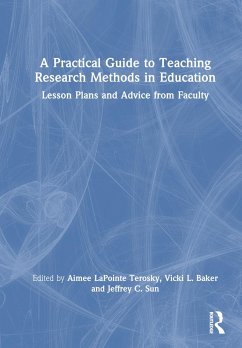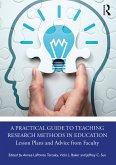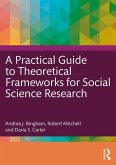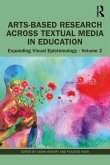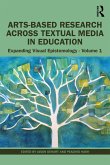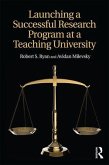A Practical Guide to Teaching Research Methods in Education
Lesson Plans and Advice from Faculty
Herausgeber: Terosky, Aimee Lapointe; Sun, Jeffrey C; Baker, Vicki L
A Practical Guide to Teaching Research Methods in Education
Lesson Plans and Advice from Faculty
Herausgeber: Terosky, Aimee Lapointe; Sun, Jeffrey C; Baker, Vicki L
- Gebundenes Buch
- Merkliste
- Auf die Merkliste
- Bewerten Bewerten
- Teilen
- Produkt teilen
- Produkterinnerung
- Produkterinnerung
A Practical Guide to Teaching Research Methods in Education brings together more than 60 faculty experts. The contributors share detailed lesson plans about selected research concepts or skills in education and related disciplines, as well as discussions of the intellectual preparation needed to effectively teach the lesson.
Andere Kunden interessierten sich auch für
![A Practical Guide to Teaching Research Methods in Education A Practical Guide to Teaching Research Methods in Education]() A Practical Guide to Teaching Research Methods in Education49,99 €
A Practical Guide to Teaching Research Methods in Education49,99 €![The Handbook of Teaching Qualitative and Mixed Research Methods The Handbook of Teaching Qualitative and Mixed Research Methods]() The Handbook of Teaching Qualitative and Mixed Research Methods48,99 €
The Handbook of Teaching Qualitative and Mixed Research Methods48,99 €![A Practical Guide to Theoretical Frameworks for Social Science Research A Practical Guide to Theoretical Frameworks for Social Science Research]() Andrea J. BinghamA Practical Guide to Theoretical Frameworks for Social Science Research51,99 €
Andrea J. BinghamA Practical Guide to Theoretical Frameworks for Social Science Research51,99 €![A Practical Guide to Theoretical Frameworks for Social Science Research A Practical Guide to Theoretical Frameworks for Social Science Research]() Andrea J. BinghamA Practical Guide to Theoretical Frameworks for Social Science Research159,99 €
Andrea J. BinghamA Practical Guide to Theoretical Frameworks for Social Science Research159,99 €![Arts-Based Research Across Visual Media in Education Arts-Based Research Across Visual Media in Education]() Arts-Based Research Across Visual Media in Education61,99 €
Arts-Based Research Across Visual Media in Education61,99 €![Arts-Based Research Across Textual Media in Education Arts-Based Research Across Textual Media in Education]() Arts-Based Research Across Textual Media in Education61,99 €
Arts-Based Research Across Textual Media in Education61,99 €![Launching a Successful Research Program at a Teaching University Launching a Successful Research Program at a Teaching University]() Robert S. Ryan (USA Kutztown University of Pennsylvania)Launching a Successful Research Program at a Teaching University66,99 €
Robert S. Ryan (USA Kutztown University of Pennsylvania)Launching a Successful Research Program at a Teaching University66,99 €-
-
-
A Practical Guide to Teaching Research Methods in Education brings together more than 60 faculty experts. The contributors share detailed lesson plans about selected research concepts or skills in education and related disciplines, as well as discussions of the intellectual preparation needed to effectively teach the lesson.
Hinweis: Dieser Artikel kann nur an eine deutsche Lieferadresse ausgeliefert werden.
Hinweis: Dieser Artikel kann nur an eine deutsche Lieferadresse ausgeliefert werden.
Produktdetails
- Produktdetails
- Verlag: Taylor & Francis Ltd
- Seitenzahl: 320
- Erscheinungstermin: 23. März 2023
- Englisch
- Abmessung: 244mm x 170mm x 21mm
- Gewicht: 714g
- ISBN-13: 9781032186733
- ISBN-10: 1032186739
- Artikelnr.: 66749208
- Herstellerkennzeichnung
- Libri GmbH
- Europaallee 1
- 36244 Bad Hersfeld
- gpsr@libri.de
- Verlag: Taylor & Francis Ltd
- Seitenzahl: 320
- Erscheinungstermin: 23. März 2023
- Englisch
- Abmessung: 244mm x 170mm x 21mm
- Gewicht: 714g
- ISBN-13: 9781032186733
- ISBN-10: 1032186739
- Artikelnr.: 66749208
- Herstellerkennzeichnung
- Libri GmbH
- Europaallee 1
- 36244 Bad Hersfeld
- gpsr@libri.de
Aimee LaPointe Terosky is Professor of Educational Leadership, Director of the Interdisciplinary Doctor of Educational Leadership program, and university liaison to School District of Philadelphia at Saint Joseph's University, USA. Her expertise in K-12 and Higher Education is in teaching/learning, urban principal and faculty careers, and qualitative research. Vicki L. Baker is the E. Maynard Aris Endowed Professor in Economics and Management at Albion College, USA. She currently serves as the faculty director of the Albion College Community Collaborative. Her most recent book is Managing Your Academic Career: A Guide to Re-Envision Mid-Career (Routledge 2022). Jeffrey C. Sun is professor of higher education and law and distinguished university scholar at the University of Louisville. Dr. Sun's research examines the extent to which policy instruments, other legal actions, and innovative interventions advance or inhibit academic operations through college teaching, learning, and knowledge creation.
Section I: Topics, Problems, and Research Questions; 1. Introduction to
Section I: Research Topics, Problems, and Questions 2. From Personal
Passion to Hot Topics: Selecting a Topic to Research 3. Articulating a
Research Problem and its Rationale: Using Graphical Depictions, Exemplars,
and Students' Own Work 4. Branch out: Using Tree Diagrams to Select and
Develop Research Questions; Section II: Literature Review and
Theoretical/Conceptual Framework 5. Introduction to Section II: Literature
Review and Theoretical/Conceptual Framework 6. Connecting Pieces to the
Puzzle: Finding and Maintaining Resources 7. The Candy Sort: Organizing the
Literature Review 8. Theoretical and Conceptual Frameworks: Understanding
the Role of Theory in Congruent Research Designs; Section III: Research
Design 9. Introduction to Section III: Research Design 10. Visualize Your
Research Design: Moving from Research Questions to Research Design 11.
Let's Road Trip: Aligning Theoretical Frameworks, Research Questions &
Research Design 12. The Self and Research: Positionality through Artifacts
13. Trustworthiness and Ethics in Research: Using Reflexivity to See the
Self in Ethical Research; Section IV: Quantitative Methods 14. Introduction
to Section IV: Quantitative Methods 15. Making Sense of Multivariate
Analysis: Real World Applications 16. Linear regression: A Student-driven
Application of Team-based Learning 17. Hands-on Application of Exploratory
Factor Analysis in Educational Research 18. Trending Topic: Teaching
Difference-in-differences in a Quasi-experimental Methods Course; Section
V: Qualitative Methods 19. Introduction to Section V: Qualitative Methods
20. Listening Deeply: Preparing to Facilitate Interviews and Focus Groups
21. Write What You See, Not What You Know: Learning the Method of
Observation Through the Visual Arts 22. On the Recovery of Black Life: A
Holistic Approach to Document Analysis 23. Emerging Approaches: Ensuring a
Pyramid of Congruence when using Critical and Poststructural Theories in
Qualitative Educational Research 24. Exploring How Epistemologies Guide the
Process of Coding Data and Developing Themes; Section VI: Mixed Methods
25. Introduction to Section VI: Mixed Methods 26. Low Hanging Fruit, Ripe
for Inquiry: Considering the Quantitative Dimensions of Mixed Methods
Research 27. Creating your Masterpiece: Applying Brush Strokes to
Qualitative Exploration of Mixed Methods Research 28. Presenting and
Visualizing a Mixed Methods Study; Section VII: Findings and Discussion
29. Introduction to Section VII: Findings and Discussion 30. An
Introduction to Regression using Critical Quantitative Thinking 31. Show
the Story: Presenting Qualitative Findings 32. Block by Block: Building a
Discussion Section 33. Making the Theoretical Practical: Implications for
Theory 34. The Donut Memo: Writing for Policymakers and Practitioners;
Section VIII: Special Topics 35. Introduction to Section VIII: Special
Topics 36. Scholarly Identity Development of Undergraduate Researchers: A
Lesson Plan for Professional Development 37. Developing Students' Cultural
Competence through Video Interviews 38. Preparing Students for
Community-engaged Scholarship: A Lesson Plan for Collaborative Inquiry
Grounded in Awareness of Self and Others 39. Teaching Policy Implications:
Can You Have Your Cake and Eat it Too? 40. Introducing Scholars to Public
Writing; Closing Words: Helping Students to Learn Research and Become
Researchers
Section I: Research Topics, Problems, and Questions 2. From Personal
Passion to Hot Topics: Selecting a Topic to Research 3. Articulating a
Research Problem and its Rationale: Using Graphical Depictions, Exemplars,
and Students' Own Work 4. Branch out: Using Tree Diagrams to Select and
Develop Research Questions; Section II: Literature Review and
Theoretical/Conceptual Framework 5. Introduction to Section II: Literature
Review and Theoretical/Conceptual Framework 6. Connecting Pieces to the
Puzzle: Finding and Maintaining Resources 7. The Candy Sort: Organizing the
Literature Review 8. Theoretical and Conceptual Frameworks: Understanding
the Role of Theory in Congruent Research Designs; Section III: Research
Design 9. Introduction to Section III: Research Design 10. Visualize Your
Research Design: Moving from Research Questions to Research Design 11.
Let's Road Trip: Aligning Theoretical Frameworks, Research Questions &
Research Design 12. The Self and Research: Positionality through Artifacts
13. Trustworthiness and Ethics in Research: Using Reflexivity to See the
Self in Ethical Research; Section IV: Quantitative Methods 14. Introduction
to Section IV: Quantitative Methods 15. Making Sense of Multivariate
Analysis: Real World Applications 16. Linear regression: A Student-driven
Application of Team-based Learning 17. Hands-on Application of Exploratory
Factor Analysis in Educational Research 18. Trending Topic: Teaching
Difference-in-differences in a Quasi-experimental Methods Course; Section
V: Qualitative Methods 19. Introduction to Section V: Qualitative Methods
20. Listening Deeply: Preparing to Facilitate Interviews and Focus Groups
21. Write What You See, Not What You Know: Learning the Method of
Observation Through the Visual Arts 22. On the Recovery of Black Life: A
Holistic Approach to Document Analysis 23. Emerging Approaches: Ensuring a
Pyramid of Congruence when using Critical and Poststructural Theories in
Qualitative Educational Research 24. Exploring How Epistemologies Guide the
Process of Coding Data and Developing Themes; Section VI: Mixed Methods
25. Introduction to Section VI: Mixed Methods 26. Low Hanging Fruit, Ripe
for Inquiry: Considering the Quantitative Dimensions of Mixed Methods
Research 27. Creating your Masterpiece: Applying Brush Strokes to
Qualitative Exploration of Mixed Methods Research 28. Presenting and
Visualizing a Mixed Methods Study; Section VII: Findings and Discussion
29. Introduction to Section VII: Findings and Discussion 30. An
Introduction to Regression using Critical Quantitative Thinking 31. Show
the Story: Presenting Qualitative Findings 32. Block by Block: Building a
Discussion Section 33. Making the Theoretical Practical: Implications for
Theory 34. The Donut Memo: Writing for Policymakers and Practitioners;
Section VIII: Special Topics 35. Introduction to Section VIII: Special
Topics 36. Scholarly Identity Development of Undergraduate Researchers: A
Lesson Plan for Professional Development 37. Developing Students' Cultural
Competence through Video Interviews 38. Preparing Students for
Community-engaged Scholarship: A Lesson Plan for Collaborative Inquiry
Grounded in Awareness of Self and Others 39. Teaching Policy Implications:
Can You Have Your Cake and Eat it Too? 40. Introducing Scholars to Public
Writing; Closing Words: Helping Students to Learn Research and Become
Researchers
Section I: Topics, Problems, and Research Questions; 1. Introduction to
Section I: Research Topics, Problems, and Questions 2. From Personal
Passion to Hot Topics: Selecting a Topic to Research 3. Articulating a
Research Problem and its Rationale: Using Graphical Depictions, Exemplars,
and Students' Own Work 4. Branch out: Using Tree Diagrams to Select and
Develop Research Questions; Section II: Literature Review and
Theoretical/Conceptual Framework 5. Introduction to Section II: Literature
Review and Theoretical/Conceptual Framework 6. Connecting Pieces to the
Puzzle: Finding and Maintaining Resources 7. The Candy Sort: Organizing the
Literature Review 8. Theoretical and Conceptual Frameworks: Understanding
the Role of Theory in Congruent Research Designs; Section III: Research
Design 9. Introduction to Section III: Research Design 10. Visualize Your
Research Design: Moving from Research Questions to Research Design 11.
Let's Road Trip: Aligning Theoretical Frameworks, Research Questions &
Research Design 12. The Self and Research: Positionality through Artifacts
13. Trustworthiness and Ethics in Research: Using Reflexivity to See the
Self in Ethical Research; Section IV: Quantitative Methods 14. Introduction
to Section IV: Quantitative Methods 15. Making Sense of Multivariate
Analysis: Real World Applications 16. Linear regression: A Student-driven
Application of Team-based Learning 17. Hands-on Application of Exploratory
Factor Analysis in Educational Research 18. Trending Topic: Teaching
Difference-in-differences in a Quasi-experimental Methods Course; Section
V: Qualitative Methods 19. Introduction to Section V: Qualitative Methods
20. Listening Deeply: Preparing to Facilitate Interviews and Focus Groups
21. Write What You See, Not What You Know: Learning the Method of
Observation Through the Visual Arts 22. On the Recovery of Black Life: A
Holistic Approach to Document Analysis 23. Emerging Approaches: Ensuring a
Pyramid of Congruence when using Critical and Poststructural Theories in
Qualitative Educational Research 24. Exploring How Epistemologies Guide the
Process of Coding Data and Developing Themes; Section VI: Mixed Methods
25. Introduction to Section VI: Mixed Methods 26. Low Hanging Fruit, Ripe
for Inquiry: Considering the Quantitative Dimensions of Mixed Methods
Research 27. Creating your Masterpiece: Applying Brush Strokes to
Qualitative Exploration of Mixed Methods Research 28. Presenting and
Visualizing a Mixed Methods Study; Section VII: Findings and Discussion
29. Introduction to Section VII: Findings and Discussion 30. An
Introduction to Regression using Critical Quantitative Thinking 31. Show
the Story: Presenting Qualitative Findings 32. Block by Block: Building a
Discussion Section 33. Making the Theoretical Practical: Implications for
Theory 34. The Donut Memo: Writing for Policymakers and Practitioners;
Section VIII: Special Topics 35. Introduction to Section VIII: Special
Topics 36. Scholarly Identity Development of Undergraduate Researchers: A
Lesson Plan for Professional Development 37. Developing Students' Cultural
Competence through Video Interviews 38. Preparing Students for
Community-engaged Scholarship: A Lesson Plan for Collaborative Inquiry
Grounded in Awareness of Self and Others 39. Teaching Policy Implications:
Can You Have Your Cake and Eat it Too? 40. Introducing Scholars to Public
Writing; Closing Words: Helping Students to Learn Research and Become
Researchers
Section I: Research Topics, Problems, and Questions 2. From Personal
Passion to Hot Topics: Selecting a Topic to Research 3. Articulating a
Research Problem and its Rationale: Using Graphical Depictions, Exemplars,
and Students' Own Work 4. Branch out: Using Tree Diagrams to Select and
Develop Research Questions; Section II: Literature Review and
Theoretical/Conceptual Framework 5. Introduction to Section II: Literature
Review and Theoretical/Conceptual Framework 6. Connecting Pieces to the
Puzzle: Finding and Maintaining Resources 7. The Candy Sort: Organizing the
Literature Review 8. Theoretical and Conceptual Frameworks: Understanding
the Role of Theory in Congruent Research Designs; Section III: Research
Design 9. Introduction to Section III: Research Design 10. Visualize Your
Research Design: Moving from Research Questions to Research Design 11.
Let's Road Trip: Aligning Theoretical Frameworks, Research Questions &
Research Design 12. The Self and Research: Positionality through Artifacts
13. Trustworthiness and Ethics in Research: Using Reflexivity to See the
Self in Ethical Research; Section IV: Quantitative Methods 14. Introduction
to Section IV: Quantitative Methods 15. Making Sense of Multivariate
Analysis: Real World Applications 16. Linear regression: A Student-driven
Application of Team-based Learning 17. Hands-on Application of Exploratory
Factor Analysis in Educational Research 18. Trending Topic: Teaching
Difference-in-differences in a Quasi-experimental Methods Course; Section
V: Qualitative Methods 19. Introduction to Section V: Qualitative Methods
20. Listening Deeply: Preparing to Facilitate Interviews and Focus Groups
21. Write What You See, Not What You Know: Learning the Method of
Observation Through the Visual Arts 22. On the Recovery of Black Life: A
Holistic Approach to Document Analysis 23. Emerging Approaches: Ensuring a
Pyramid of Congruence when using Critical and Poststructural Theories in
Qualitative Educational Research 24. Exploring How Epistemologies Guide the
Process of Coding Data and Developing Themes; Section VI: Mixed Methods
25. Introduction to Section VI: Mixed Methods 26. Low Hanging Fruit, Ripe
for Inquiry: Considering the Quantitative Dimensions of Mixed Methods
Research 27. Creating your Masterpiece: Applying Brush Strokes to
Qualitative Exploration of Mixed Methods Research 28. Presenting and
Visualizing a Mixed Methods Study; Section VII: Findings and Discussion
29. Introduction to Section VII: Findings and Discussion 30. An
Introduction to Regression using Critical Quantitative Thinking 31. Show
the Story: Presenting Qualitative Findings 32. Block by Block: Building a
Discussion Section 33. Making the Theoretical Practical: Implications for
Theory 34. The Donut Memo: Writing for Policymakers and Practitioners;
Section VIII: Special Topics 35. Introduction to Section VIII: Special
Topics 36. Scholarly Identity Development of Undergraduate Researchers: A
Lesson Plan for Professional Development 37. Developing Students' Cultural
Competence through Video Interviews 38. Preparing Students for
Community-engaged Scholarship: A Lesson Plan for Collaborative Inquiry
Grounded in Awareness of Self and Others 39. Teaching Policy Implications:
Can You Have Your Cake and Eat it Too? 40. Introducing Scholars to Public
Writing; Closing Words: Helping Students to Learn Research and Become
Researchers

